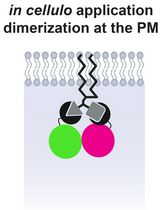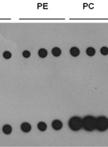- Submit a Protocol
- Receive Our Alerts
- Log in
- /
- Sign up
- My Bio Page
- Edit My Profile
- Change Password
- Log Out
- EN
- EN - English
- CN - 中文
- Protocols
- Articles and Issues
- For Authors
- About
- Become a Reviewer
- EN - English
- CN - 中文
- Home
- Protocols
- Articles and Issues
- For Authors
- About
- Become a Reviewer
Quantitative Analysis of Cellular Diacylglycerol Content
Published: Vol 4, Iss 15, Aug 5, 2014 DOI: 10.21769/BioProtoc.1202 Views: 12534
Reviewed by: Hong-guang XiaFanglian He

Protocol Collections
Comprehensive collections of detailed, peer-reviewed protocols focusing on specific topics
Related protocols

Optogenetic Tuning of Protein-protein Binding in Bilayers Using LOVTRAP
Doug Tischer and Orion D. Weiner
Sep 5, 2020 5873 Views

Lipid-Mediated Sequential Recruitment of Proteins Via Dual SLIPT and Dual SLIPTNVOC in Live Cells
Kristina V. Bayer and Richard Wombacher
Nov 5, 2025 1487 Views
Abstract
Diacylglycerol (DAG) is a bioactive lipid with diverse biological roles. DAG transiently accumulates in a membrane upon receipt of an appropriate stimulus that activates phospholipase C to cleave phospholipids. The resulting hydrolysis product DAG binds to proteins such as protein kinase C to initiate a variety of downstream cellular processes. DAG kinases attenuate such responses by converting DAG to phosphatidic acid.
This protocol describes an assay designed to quantify cellular DAG levels. The assay exploits the enzymatic conversion of DAG (sn-1,2-diacylglycerol) to phosphatidic acid (1,2-diacyl- sn-glycerol-3-phosphate) in conjunction with the incorporation of a radiolabeled phosphate group by DAG kinase (Figure 1). This assay was described in (Strijbis et al., 2013).

Figure 1. The enzymatic conversion of DAG to phosphatidic acid by DAG kinase
Materials and Reagents
- Cells (~2 x 106 cells)
- Octyl-β-D-glucoside (Sigma-Aldrich, catalog number: O8001 )
- Cardiolipin (Sigma-Aldrich, catalog number: C5646 )
- Diethylenetriaminepenta acetic acid (DETAPAC) (Sigma-Aldrich, catalog number: D6518 )
- Imidazole (Sigma-Aldrich, catalog number: I5513 )
- NaCl (Sigma-Aldrich, catalog number: S7653 )
- MgCl2 (Sigma-Aldrich, catalog number: M8266 )
- EGTA (Boston Bio Products, catalog number: BM-151 )
- DTT (Sigma-Aldrich, catalog number: D0632 )
- DAG kinase (Sigma-Aldrich, catalog number: D3065 )
- γ33-ATP (PerkinElmer, catalog number: NEG302H001MC )
- DAG (Avanti Polar Lipids)
- Phosphatidic acid (Sigma-Aldrich, catalog number: P9511 )
- Chloroform (Thermo Fisher Scientific, catalog number: C298-50 )
- Methanol (Thermo Fisher Scientific, catalog number: BP1105 )
- Acetic acid (Sigma-Aldrich, catalog number: 695092 )
- N2 gas (Middlesex Gases & Technologies)
- Acetone (Thermo Fisher Scientific, catalog number: S70090 )
Equipment
- Vortex
- Centrifuge
- Thin layer chromatography (TLC) (Whatman, catalog number: 4860-820 ) equipment (plates, developing tank)
- Phospho-scanner (e.g. Fujifilm Corporation, model: BAS-2500 )
- Phospho-imaging screens (e.g. Fujifilm Corporation, model: BAS-MS )
Procedure
- Prepare the following solutions before starting the assay
- Solubilizing buffer: 7.5% (w/v) octyl-β-D-glucoside and 5 mM cardiolipin in 1 mM diethylenetriaminepenta acetic acid (1 mM DETAPAC, pH 7.0; adjust the pH with NaOH).
- 1 mM diethylenetriaminepenta acetic acid (1 mM DETAPAC, pH 6.6; adjust the pH with NaOH).
- 2x reaction buffer: 100 mM imidazole HCl, pH 6.6, 100 mM NaCl, 25 mM MgCl2, and 2 mM EGTA.
- 100 mM DTT in H2O (prepare fresh).
- Solubilizing buffer: 7.5% (w/v) octyl-β-D-glucoside and 5 mM cardiolipin in 1 mM diethylenetriaminepenta acetic acid (1 mM DETAPAC, pH 7.0; adjust the pH with NaOH).
- Sample preparation and total lipid extraction
- Wash cells (about 2 x 106) with phosphate-buffered saline (PBS) and extract lipids according to Bligh and Dyer (Bligh et al., 1959).
- Dry the chloroform/methanol phase under a gentle flow of N2.
- Wash cells (about 2 x 106) with phosphate-buffered saline (PBS) and extract lipids according to Bligh and Dyer (Bligh et al., 1959).
- DAG kinase assay
This assay was adapted from Preiss et al. (1986). Steps from 4 onwards need to be performed in lab areas certified for radioactivity work and the proper lab practice should be followed.- Dissolve the dried lipids in 40 µl of solubilizing buffer by vigorously vortexing for 20 sec.
- Incubate the dissolved lipid at room temperature for 10 min.
- Keep the samples on ice for 5 min and add 100 µl of 2x reaction buffer, 4 µl of 100 mM DTT and 20 µl of E. coli DAG kinase while keeping the samples on ice.
- Initiate the reaction by addition of 3 µCi [γ33]-ATP prepared by dilution in 20 µl of 1 mM DETAPAC (pH 6.6).
- After vortexing briefly, incubate the reaction at 25 °C for 30 min.
- Stop the reaction by keeping the tubes on ice, and re-extract and dry lipids as described above.
- Dissolve the dried lipids in ~50 µl of chloroform/methanol (2/1, v/v).
- Apply the lipid extracts on a TLC plate along with lipid standards (Phospatidic acid and DAG).
- Run the TLC plate for 30 min by placing it in a TLC chamber that contains about 75 ml of acetone.
- Dry the TLC plate and further develop the TLC plate in a chloroform/methanol/acetic acid (65/15/5, v/v/v) solution.
- Dry the TLC plate using hair dryer and expose it to phospho-imaging screens.
- Detect radiolabeled lipids by scanning the phospho-imaging screen using BAS-2500 scanner.
- Dissolve the dried lipids in 40 µl of solubilizing buffer by vigorously vortexing for 20 sec.
Acknowledgments
This protocol is adapted from Strijbis et al. (2013). Funding for this work was received from the National Institutes of Health (GM040266; GRF and F32 AI729353; VKV), (H.L.P.), Organization for Scientific Research (KS, MDW, FGT) and the Clay Postdoctoral Fellowship (KS).
References
- Bligh, E. G. and Dyer, W. J. (1959). A rapid method of total lipid extraction and purification. Can J Biochem Physiol 37(8): 911-917.
- Preiss, J., Loomis, C. R., Bishop, W. R., Stein, R., Niedel, J. E. and Bell, R. M. (1986). Quantitative measurement of sn-1,2-diacylglycerols present in platelets, hepatocytes, and ras- and sis-transformed normal rat kidney cells. J Biol Chem 261(19): 8597-8600.
- Strijbis, K., Tafesse, F. G., Fairn, G. D., Witte, M. D., Dougan, S. K., Watson, N., Spooner, E., Esteban, A., Vyas, V. K., Fink, G. R., Grinstein, S. and Ploegh, H. L. (2013). Bruton's Tyrosine Kinase (BTK) and Vav1 contribute to Dectin1-dependent phagocytosis of Candida albicans in macrophages. PLoS Pathog 9(6): e1003446.
Article Information
Copyright
© 2014 The Authors; exclusive licensee Bio-protocol LLC.
How to cite
Readers should cite both the Bio-protocol article and the original research article where this protocol was used:
- Tafesse, F. G., Strijbis, K. and Ploegh, H. L. (2014). Quantitative Analysis of Cellular Diacylglycerol Content. Bio-protocol 4(15): e1202. DOI: 10.21769/BioProtoc.1202.
- Strijbis, K., Tafesse, F. G., Fairn, G. D., Witte, M. D., Dougan, S. K., Watson, N., Spooner, E., Esteban, A., Vyas, V. K., Fink, G. R., Grinstein, S. and Ploegh, H. L. (2013). Bruton's Tyrosine Kinase (BTK) and Vav1 contribute to Dectin1-dependent phagocytosis of Candida albicans in macrophages. PLoS Pathog 9(6): e1003446.
Category
Biochemistry > Lipid > Lipid measurement
Biochemistry > Lipid > Lipid isolation
Biochemistry > Protein > Interaction > Protein-lipid interaction
Do you have any questions about this protocol?
Post your question to gather feedback from the community. We will also invite the authors of this article to respond.
Share
Bluesky
X
Copy link









